 Technology
Technology  Technology
Technology  Music
Music Top 10 Songs That Tell Stories Better Than Books
 Humans
Humans 10 Ways News Media Manipulate Readers
 Weird Stuff
Weird Stuff 10 Crazy-Specific Rules Dallas Cowboys Cheerleaders Must Follow
 Pop Culture
Pop Culture 10 Reasons We’ll Always Need Superman
 Our World
Our World 10 Ancient Places That Dropped Surprising New Finds
 Animals
Animals Ten Mind-Boggling Discoveries About Birds
 Crime
Crime 10 Terrifying Women Who Committed Murder by Torture
 Technology
Technology 10 Animal Adaptations Revolutionizing Human Technology
 Humans
Humans 10 Darkest Details of the Infamous Lobotomy
 Technology
Technology 10 Signs That “Made in the U.S.A.” Still Lives
 Music
Music Top 10 Songs That Tell Stories Better Than Books
 Humans
Humans 10 Ways News Media Manipulate Readers
Who's Behind Listverse?

Jamie Frater
Head Editor
Jamie founded Listverse due to an insatiable desire to share fascinating, obscure, and bizarre facts. He has been a guest speaker on numerous national radio and television stations and is a five time published author.
More About Us Weird Stuff
Weird Stuff 10 Crazy-Specific Rules Dallas Cowboys Cheerleaders Must Follow
 Pop Culture
Pop Culture 10 Reasons We’ll Always Need Superman
 Our World
Our World 10 Ancient Places That Dropped Surprising New Finds
 Animals
Animals Ten Mind-Boggling Discoveries About Birds
 Crime
Crime 10 Terrifying Women Who Committed Murder by Torture
 Technology
Technology 10 Animal Adaptations Revolutionizing Human Technology
 Humans
Humans 10 Darkest Details of the Infamous Lobotomy
Top 10 Important Blunders of Ancient Science
This list is our first prize winner for the site launch competition. Congratulations to the author, Tristan Bradshaw. One of the most tempting mistakes in studying history is to judge the past by modern standards. Nowhere is this more easily seen than in the contributions of ancient science. When we laugh at geocentric cosmology, or the theory of four elements, we fail to realize that, while the theories were certainly wrong, they still advanced scientific knowledge. This list explores 10 such contributions.
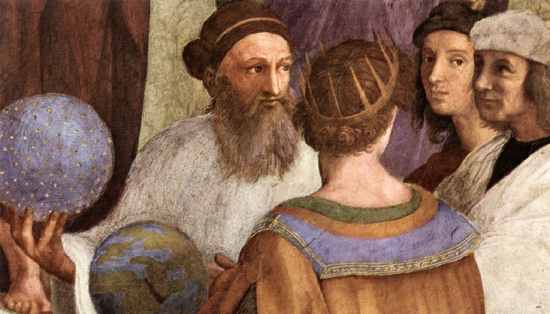
Ptolemy (born A.D. 90), was an astronomer whose model of the universe became the standard geocentric theory, until Copernicus. Ptolemy’s writings proved influential in early astronomy, and he was revered throughout the Middle Ages in Europe and Arabia. He also provided the most authoritative compilation of constellations in antiquity. Although he helped to discredit Aristarchos’ heliocentric universe (more on that later), and ensured the geocentric model would be universally accepted for the next 1,000 years, Ptolemy did much to raise the standard of astronomy.
Ptolemy did this by highlighting the disjunction between mathematical models and actual, observed patterns in the stars. Because planets actually follow ellipses (a fact not proven until Kepler), ancient astronomers relied on epicycles (circles within circles within circles) to explain the motion of the planets. Epicycles can be quite accurate, but they are never perfect. Ptolemy’s work on astronomy did much to highlight the problems of epicycles, ensuring that later astronomers continued to search for better explanations.

Euclid (born c. 330 B.C.), is most famous for his contributions to geometry, but he also wrote treatises on astronomy and optics. Euclid’s treatment of optics reflects his love of geometry. Euclid argued that vision occurs when rays emit from the eye to form a cone. From there, Euclid proceeds geometrically. Everything the rays touch is seen. If one reduces vision to a geometric exercise, Euclid’s treatment of optics is profound. Issues such as medium, light and whether there was a physical connection between the eye and the viewed object were passed over. Nevertheless, Euclid’s treatment of the subject would be influential until the age of Ptolemy.

Galen, born in A.D. 129 in Asia Minor, was the second most revered physician in antiquity, after Hippocrates. He served as the court physician for three Roman emperors and was one of the most prolific writers in the ancient world. His contributions to medicine, anatomy and physiology are numerous and profound. Not unlike the fictional Gregory House, Galen was known for being more interested in understanding the cause of a disease than the comfort of his patients, whom he tended to treat as specimens. The contribution to science that puts Galen on this list is not for any particular discovery or theory, but the absolute rigor and high standard he applied to developing medical knowledge.
Human dissection was outlawed in Rome, so Galen used pigs and monkeys to understand anatomy. His careful and meticulous dissections revealed many anatomical features that had been missed by others, such as his discovery that arteries contain blood. His theories of human physiology and disease were based directly on this research, leading to conclusions difficult for critics to dispute. Unfortunately, Galen’s careful research led him to conclude that excess blood was frequently the cause of diseases and he helped to popularize bloodletting, a traditional medical practice in the Eastern Mediterranean, that had never gained popularity in Italy. Modern medicine has shown that, except in a small number of situations, bloodletting is useless and actually harmful, but Galen’s authority and defense of the practice ensured bloodletting would become an accepted procedure until the 19th century. His careful work, while wrong in its conclusions, raised the standard of medical theory immeasurably.
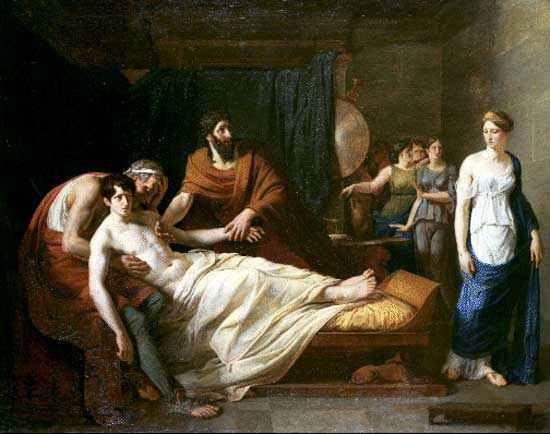
Herophilos was born in 335 B.C. — almost 500 years before Galen — in Asia Minor. He founded a school in Alexandria, Egypt, where he entered the service of the Ptolemaic dynasty. With Ptolemaic patronage, Herophilos and his students were permitted to violate the sanctity of the dead and dissect humans. Throughout antiquity, Mediterranean cultures maintained a strong taboo against cutting or dissecting the dead. Herophilos and his students were the first-known Greeks to violate this taboo in order to study anatomy. They may have even dissected condemned prisoners while they were still alive (which is known as vivisection).
Herophilos’ findings did much to advance knowledge of human anatomy. Much of the terminology he coined is still used in modern medicine. His student, Erasistratos, built on Herophilos’ findings and argued that “pneuma” ran through arteries and nerves. Pneuma (“breath” in Greek) was a substance imagined to be the life force that enables much of the body to run. Erasistratos hypothesized that pneuma was pulled from the air via the lungs and sent through the arteries. It finally arrived at the brain, which refined the pneuma and sent it through nerves to control the body and feel sensations.
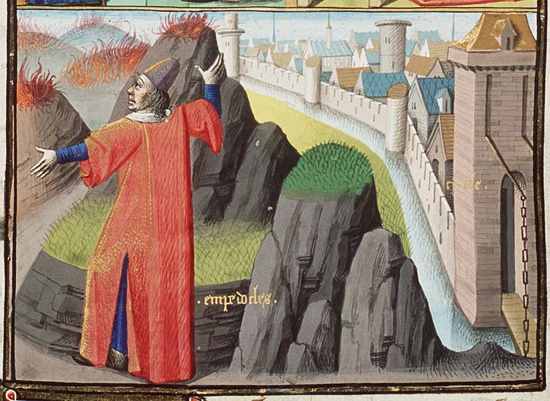
Empedocles (born c. 490 B.C.), was among the last of the Presocratics, philosophers before Socrates who wrote in verse. It was Empedocles who first hypothesized the classic four elements: fire, earth, water and air. Empedocles argued that all material is a mix of these four elements. Wood, for example, is made primarily of fire and earth. Burning wood separates the fire, leaving only earth (ash) behind. His notion that all physical material can be broken down into just mixtures of earth, water, air and fire seems hopelessly naive, but the idea had a profound impact on the physical sciences.
Empedocles’ true contribution to science, however, was not what he was arguing for, but, rather,what he was arguing against. Empedocles was attacking the philosophies of Heraclitos and Parmenides. Heraclitus argued that reality is perpetually changing, and that material must come into and out of existence for change to exist. Parmenides argued that all change is an illusion, including time and movement (his student, Zeno, illustrated this with several famous paradoxes). Empedocles’ theory of four elements was his attempt to show that material, in its elemental form, cannot be destroyed or created. Change is a result of things being mixed together or separated. Empedocles’ ideas anticipated the first law of thermodynamics by more than 2,000 years, and his notion that material is comprised of indivisible elements has proven invaluable to the physical sciences.
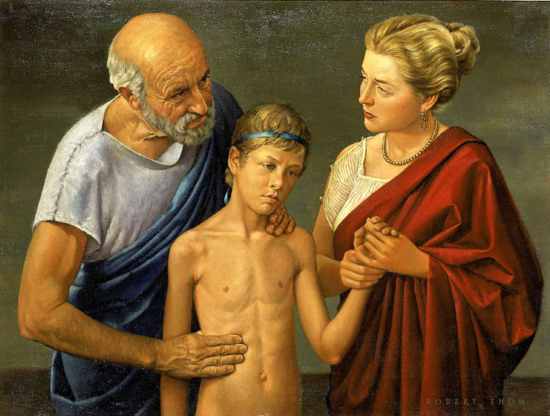
Hippocrates (born c. 460 B.C.), is perhaps most famous for the oath that bears his name. It is difficult to separate what Hippocrates believed versus what his students believed. Since many of the texts that he supposedly wrote differ greatly in style and date of composition, none can be definitively identified as coming from him directly. Hippocrates developed the theory of four humors, which was the mainstream theory of human physiology, until it was disproved and displaced by modern medicine in the 19th century. The theory of four humors states that the body’s principle fluids are blood, phlegm, black bile and yellow bile. Disease arises from a disproportion of these four fluids, or humors. Treatment required restoring the balance, usually through a change in diet or exercise.
Hippocrates’ theory of humors has been thoroughly debunked, but Hippocrates contributed to science by convincing other physicians that disease has a natural cause and is not a punishment from the Gods. By arguing for disease as an imbalance in bodily fluids, Hippocrates helped separate medicine from folk remedies. He did not change the practice of medicine universally. Folk medicine and sacrifices to Asclepius and Apollo never died out. However, he and his followers helped elevate the practice to a legitimate science.
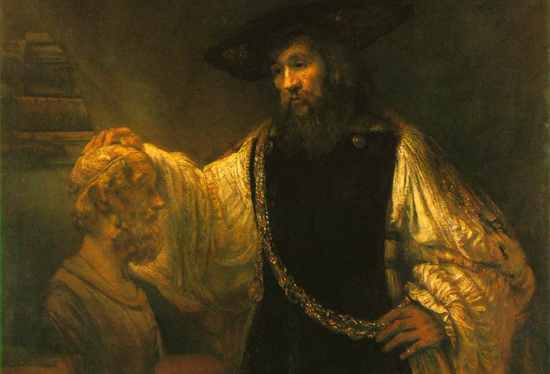
Aristotle (born 384 B.C.), was a Macedonian student in Plato’s school in Athens. Aristotle is, of course, famous as one of the most important philosophers in history. What is often forgotten, is that Aristotle had a passion for marine biology. He wrote several treatises on the biological sciences, and many observations he made while dissecting marine animals were not confirmed until the 19th century. While his observations on anatomy were mostly accurate, his conclusions on physiology and theory could be quite wrong. An example is that he argued that all animals are in a hierarchy of complexity based on the degree of body heat. Humans were at the top and insects and worms were at the bottom. Aristotle also argued that the function of lungs and gills were to cool down the bodies of animals.
Before Aristotle, philosophers regarded the study of physics and astronomy as their highest calling. Aristotle argued that the biological sciences were worth studying because of the amount of information in them. This information was much more readily available than in astronomy or physics. Aristotle’s prestige helped to elevate the biological sciences within philosophy and he paved the way for further developments.
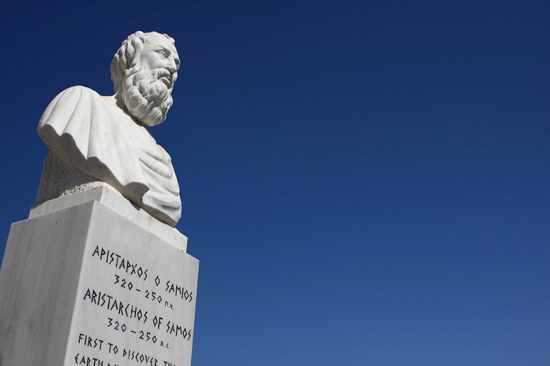
Aristarchos (born 310 B.C.), was a Greek astronomer from the island of Samos. He is known for being the first astronomer to suggest a heliocentric view of the universe. Aristarchos made careful measurements of the relative angles of the Moon and Sun. Given the level of technology available to him, it is not surprising that his measurements were off. Based on his measurements, he concluded that the diameter of the Sun is seven times the diameter of the Earth, and is 18-20 times farther from the Earth than the Moon. In fact, it is more than 400 times farther away, and 109 times the diameter of the Earth. Aristarchos’ suggestion that the Earth orbits the Sun was immediately rejected in antiquity.
Among his detractors was Cleanthes of Assos, one of the great luminaries of early Stoic philosophy. Cleanthes stated that Aristarchos should be charged with impiety for putting the Earth in motion. The greatest reason for the rejection of Aristarchos’ model was stellar parallax. If the Earth orbited the Sun, rather than remain still, then the angle of stars should change in relation to the Earth throughout the year, since the Earth’s vantage point is constantly changing. Aristarchos responded that stars are too far away for parallax to be measurable (which is true), but without proof to back this claim, it sounded more like a rationalization than a theory. Aristarchos’ theory was ultimately correct, but Aristarchos was not able to meet the burden of proof. So his theory was reasonably rejected, thus anticipating Marcello Truzzi’s famous quote, “Extraordinary claims require extraordinary proof.”
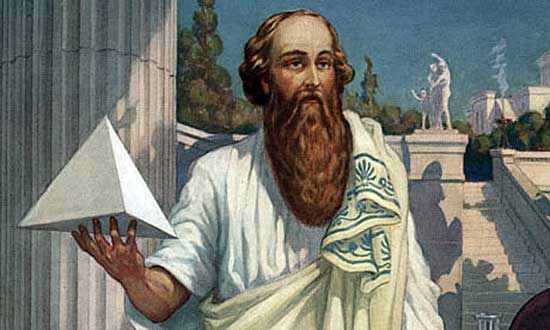
Pythagoras (born c. 570 B.C.), is most famous for the theorem he reputedly discovered. Pythagoras was among the earliest of the Presocratic philosophers, and his influence was widely felt in later philosophy. Pythagoras was fascinated by the patterns numbers make, and he built his philosophy around numbers, though he left no writings behind. He also founded one of the earliest secret societies, which endeared him to conspiracy theorists the world over. He was the first to argue that mathematics can be found in nature, but he did not stop there. Later philosophers say he did not merely believe that nature is mathematical, but that reality itself is math. He famously stated that “all is number,” perhaps believing that reality is something akin to the Matrix.
Pythagoras’ belief that numbers are reality doesn’t really add up, but he did contribute to science by showing that the universe can be captured through mathematics. Without the addition of mathematics, the study of science would never have escaped the purely theoretical. Philosophy seeks to answer questions through the application of logic, and there is nothing more logical than numbers. Later philosophers, building on Pythagoras, relied more and more heavily on mathematics to explain the world.
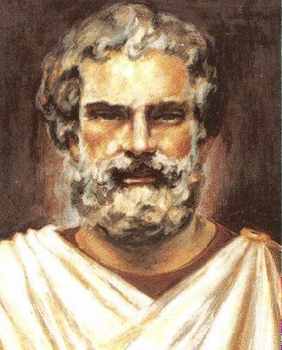
It should not be surprising that Thales (born c. 624 B.C.) is listed as number one. He is universally recognized as beginning Western philosophy by arguing that nature can be explained without invoking the Gods, and one’s explanation of how nature works must be defensible. His writings, if he wrote at all, have not survived, and we must rely on the questionable assertions of later philosophers to deduce what he believed.
Thales appears to have argued that the ultimate element is water, from which everything else is made. He may also have believed that the earth was flat and floated on water. Regardless of the specifics, he and his followers emphasized explanations of the universe that did not involve appeals to the supernatural. Each new theory his school developed was subjected to critical analysis and refined, creating a tradition of critical thinking and debate that led directly to Western philosophy.



![Top 10 Most Important Nude Scenes In Movie History [Videos] Top 10 Most Important Nude Scenes In Movie History [Videos]](https://listverse.com/wp-content/uploads/2019/09/sharonstone-150x150.jpg)




